POP sends out a survey to all of our orchard partners at the end of each season to learn about partners’ orchard successes and challenges, orchard value, community involvement, yields, distribution methods, how we perform as partners, our educational offerings, and how to improve the services POP provides. Partner participation for 2021 was slightly up from 2020 ( from 66% to 72% ) but remains lower than pre-pandemic levels of 80% participation.
Orchard Value
Every year POP asks their partners what they value most about their orchards. This is to gauge what remains most important to partners and can allow POP to further promote those aspects most favored. This year “Community and Gathering Space” moved from the bottom to the top of the list, alongside “Educational Opportunities” which also topped the list in 2020. Few votes were cast for “Low Value” and “Lowest Value”, with “Food Production and Distribution” ranking the highest in both “Low Value” and “Lowest Value.”, followed by “Community Health and Nutrition”.
The story section of the survey asks respondents to tell a story that illustrates the value of the orchard. A common theme among the stories was how the orchards created meaningful community gathering moments, whether it was a school coming out for a workday, a community dinner, or a space to meet neighbors. Some of the more touching and bittersweet stories is a volunteer that planted a tree in commemoration of their sibling that was lost to gun violence. Many partners mentioned the educational value of the orchards. Overall, it seems like the orchards offer a healing, communal refuge for many community members.
Read more of the community impact stories shared by orchard partners here.
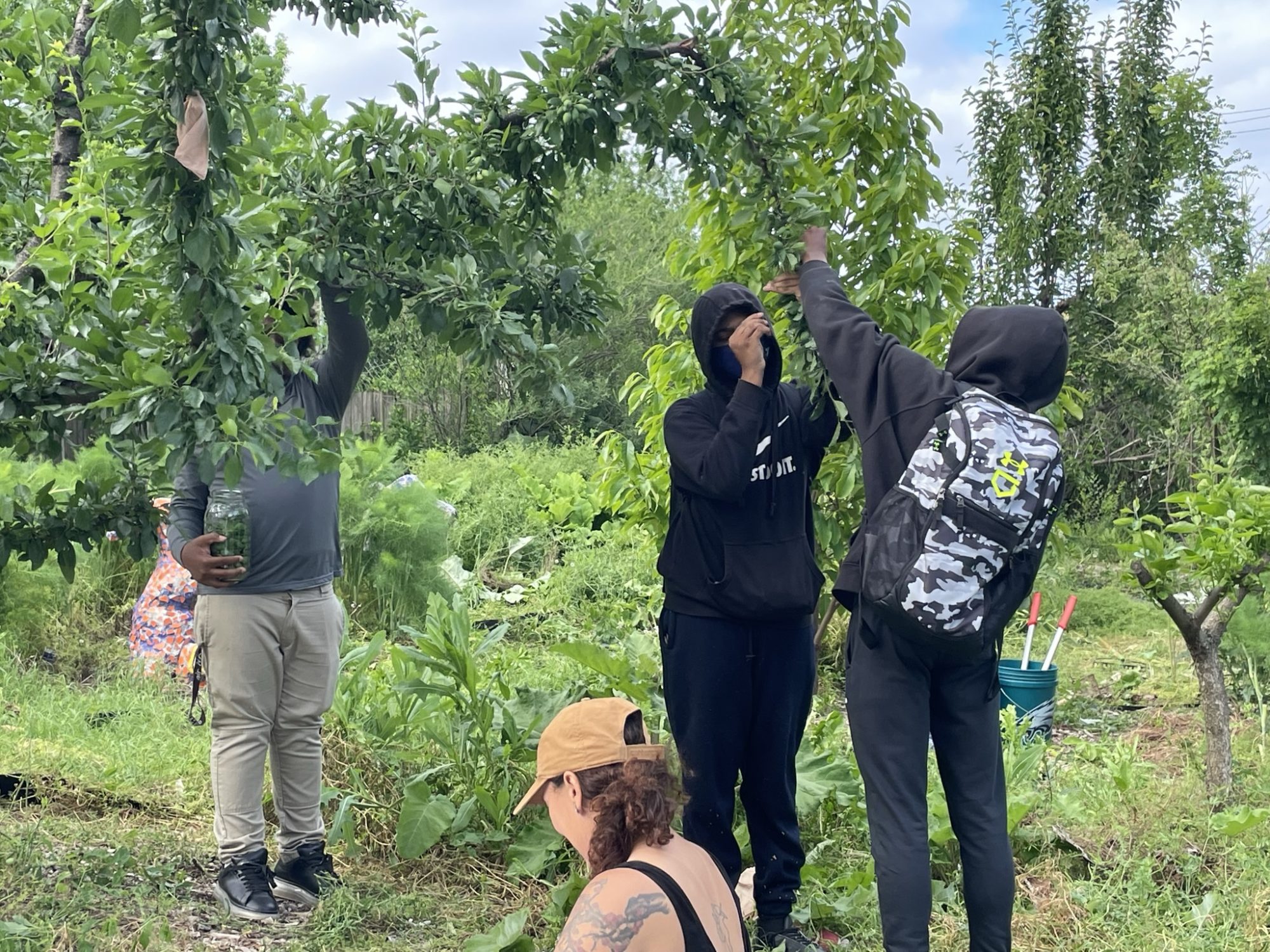
A set of questions were asked to assess the number of people involved with and affected by our orchards. Surveys reported:
Community Involvement
- A total of 300 people participated regularly (at least monthly) in orchard care throughout the city in 2021, which is just slightly above the reported total of 287 in 2020. Prior levels were 337 in 2019 and 428 in 2018.
- 2,345 people were reported to have participated at least once in orchard care throughout 2021, a big increase from 2020 when only 745 people were reported to have participated at least once. Prior levels were 3,072 in 2019, 2,404 in 2018, 4,385 in 2017, and 2,200 in 2016.
- A higher percentage than in past years, 46%, tended to their orchard weekly during the growing season in 2021, compared to 33% of respondents last year and 36% in 2019. A handful of sites (7%) tended to their orchards daily, 22% tended to the orchard twice per month, and 11% reported monthly orchard care days.
- 89.2% of respondents tended to their orchards at least monthly, continuing the trend of more frequent care over the past two years (83% in 2020 and 40% in 2019). 61% of these partners held organized workdays once or twice per month. Monthly orchard attention and volunteer workdays is a main component of POP’s recommended maintenance plan, with some groups returning to the practice of hosting outside volunteer groups. 45.7% of partners rarely or never host outside groups, while others report hosting outside volunteer groups occasionally (35%) or rarely (11%).
- The most people ever reported through this survey tasted something from a partner orchard in 2021: 6,933. This was an increase from 2020, when partners reported that 3,895 people tasted something grown in a partner orchard, as compared to 6,532 in 2019 and 4,435 in 2018.
- Similarly, 7,306 people used a POP partner orchard as a gathering space compared to 3,699 in 2020 (13,225 in 2019, 8,923 in 2018 and 5,386 in 2017). Outdoor time and gardens have continued to serve many with a much needed nature break and safe way to connect with others.
- 2,055 were reported to have participated in educational programs at orchards throughout 2021, which is a big increase from the 544 people reported to have done the same in 2020. However, these numbers are still lower than what had been reported in prior years (4,031 in 2019, 7,190 in 2018, and 3,954 in 2017). We hope and look forward to the return and rebound of garden education!
Informally, orchards were also used as a spot to wait for the bus, to practice meditation, to read a book, or to simply enjoy the shade and green. Some additional ways orchards were used included: as a way to demonstrate microclimates through the successful ripening of pomegranates against a brick wall; as community composting sites; and a space for hands-on learning by PowerCorps cohorts.
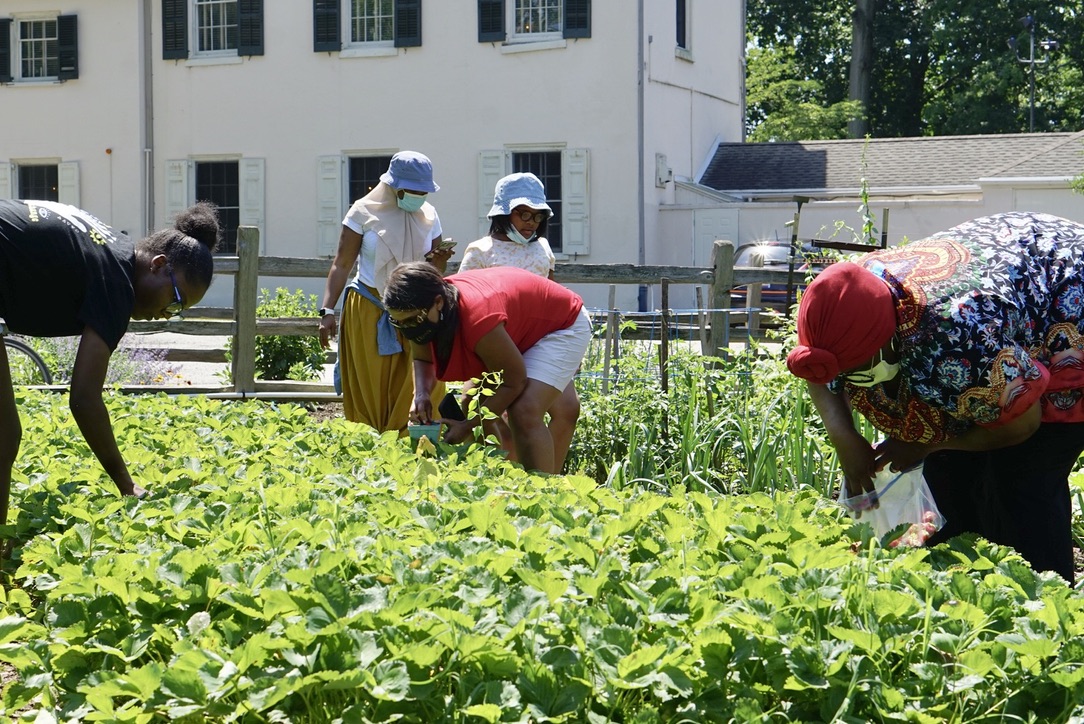
Distribution
Distribution methods vary greatly from one group to another, as expected from distribution plans submitted in partner applications and the varying missions of partner orchards. There are orchard partners whose yields are 100% harvested directly by or distributed to community members for free, some yields contribute to a variety of partners’ farmers markets and CSA memberships, some partners turn yields into value added products, and some yields are completely or partially donated to emergency food services.
With a major decrease from past years, only 31% of all recorded harvest yields at POP partner orchards were made available to community members for free (49% in 2020, 48% in 2019, 51.5% in 2018). This seems to be more of an increase in production for market based orchards rather than a decrease in harvest made available to community members for free. If adjusting to disclude the 3 largest sites that are market based (Henry Got Crops, Sankofa at Bartrams, and Grumblethorpe), 57% of all recorded harvests are harvested or distributed directly to community members for free. It should also be noted that at least in the case of Bartrams and Grumblethorpe, a lot of the farmstand and farmers market sales are via federal benefit programs like SNAP. If averaging distribution methods across all partners, each partner weighted equally, 68% of partner harvests are slated to be harvested directly by or distributed to community members for free either onsite or through outside emergency food service organizations (61% in 2020, 69% in 2019, 70% in 2018).
Taking into account yields and distribution methods reported by each partner, total produce yielded by community orchards in 2021 was distributed in the following manner:
- 31% was harvested for free by or distributed to community members (49% in 2020, 48% in 2019, 51.5% in 2018)
- 24% was sold at on-site farmstands (30% 2020, 25% 2019, 24% 2018, 8% 2017)
- 16% was sold off-site at farmers’ markets (11% 2019, 7% 2018, 8% 2017)
- 10% was donated to emergency food pantries, and (6% 2020, 4% 2019, 4% 2018, 2% 2017)
- 8% was sold via Community Supported Agriculture (CSA) shares (1% 2020, 6% 2019, 4% 2018, 1% 2017)
- 7% of ripe fruit went unharvested or was lost to pest and disease (10% 2020, 7% 2019, 9% 2018, 7% 2017)
- 4% was processed into value-added products (3% 2020, 2% 2019, 4% 2018, 6% 2017)
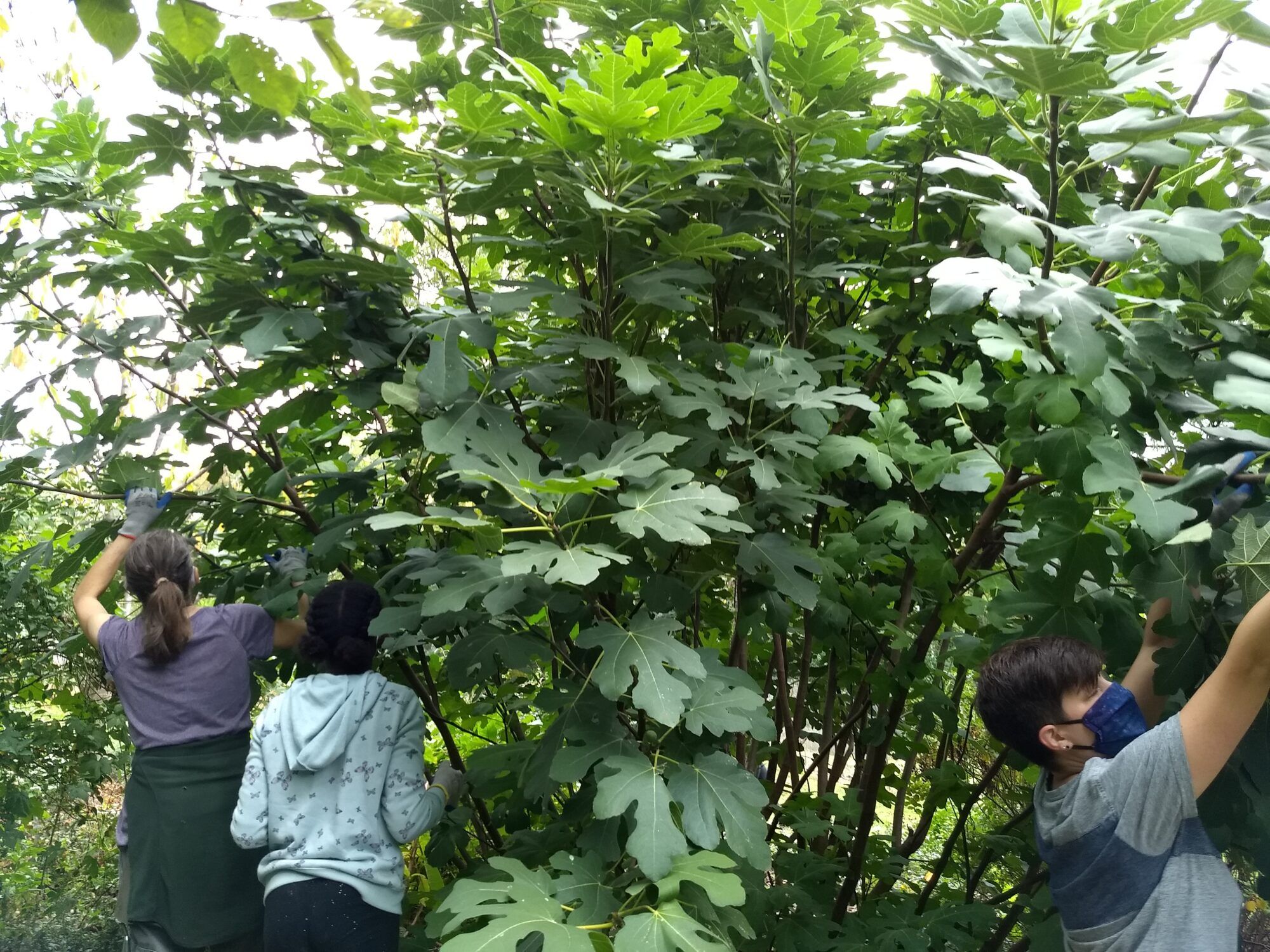
Orchard Production
While less than half of partners reported feeling like their food yields had increased from 2020 to 2021, total reported yield increased for all 18 tree crops. 2021 was a record breaking year in terms of reported harvest. Total harvest was 6264 pounds, 41% greater than our previous record set in 2019 with 4437 pounds.
Based on 2021 survey analysis of tree fruits, pawpaws and figs are the highest producers by far, followed by plums, peaches/nectarines, persimmons, asian pears, sweet cherries, european pears, and pie cherries in that order.
Out of 18 tree crops
- 18 crops increased in reported yield between 2020 to 2021.
- 8 crops with highest yield on record: Plums, Figs, Persimmons, Asian Pears, Paw paws, European Pears, Hardy Almonds, Chestnuts
- 5 crops with 2nd highest yield on record: Peaches/nectarines, Sweet Cherries, Pie Cherries, Medlars, Apricots
Poundage from fruit and nut trees based on reported yields are as follows (bolded are record yields):
- Peaches/nectarines: 425 lbs (124- 2020, 254-2019, 286-2018, 307-2017, 521-2016, 589-2015)
- Serviceberries: 26.25 pounds (20.25 -202, 86.6-2019, 71.5-2018, 80-2017, 415-2016, 69-2015) Worst year of apple cedar rust that Phil has seen in last 15 years.
- Plums: 456.4 pounds (205.6-2020, 194.5-2019, 337-2018, 14-2017, 408-2016, 284-2015) Best year yet! Plum curculio abundant in 2021, lots of black knot on plums while pruning in 2022.
- Sweet cherries: 247 pounds (154.25-2020, 218-2019, 137-2018, 172-2017, 389-2016, 168-2015)
- Apples: 194.33 pounds ( 91.25-2020, 130.5-2019, 145.5-2018, 102-2017, 347-2016, 481-2015)
- Figs: 736.1 pounds (403.5-2020, 184.5-2019, 232.5-2018, 593-2017, 296-2016, 97-2015) Best year yet! Large breba crop found across the city due to no temperatures lower than 17F in winter 2020/21.
- Persimmons: 410 pounds (24.2-2020, 233-2019, 77.5-2018, 153-2017, 250-2016, 74-2015)
- Asian pears: 357.5 pounds (143.6-2020, 335.9-2019, 225-2018, 287-2017, 228-2016, 320-2015)
- Mulberries: 89 pounds (35.5 -2020, 29-2019, 20-2018, 70-2017, 182-2016, 90-2015)
- Paw paws: 1799.1 pounds (311.5-2020, 539.8-2019, 239-2018, 218-2017, 154-2016, 56-2015)
- European Pears: 278 pounds (35.6-2020, 137.1-2019, 52-2018, 94-2017, 132-2016, 138-2015) Pie cherries: 204.5 pounds (144.5-2020, 236.2-2019, 187.8-2018, 132-2017, 91-2016, 83-2015)
- Jujubes: 7 pounds (2.02-2020, 14.5-2019, 6-2018, 20-2017, 10-2016, 40-2015)
- Medlar: 10 pounds (5-2020, 4-2019, 0-2018, 15-2017, 9-2016, 5-2015)
- Apricots: 27 pounds (6-2020, 60-2019, 23-2018, 1-2017, not previously tracked)
- Almonds: 40 pounds (23-2020, 15.4-2019, 22-2018, 24-2017, 10-2016, 10-2015)
- Hazelnuts: 46 pounds (11-2020, 90.25-2019, 105-2018, 0-2017, 0-2016, 0-2015)
- Chestnuts: 50 pounds (0-2020, 5-2019, 1-2018, 2-2017, 0-2016, 0-2015)
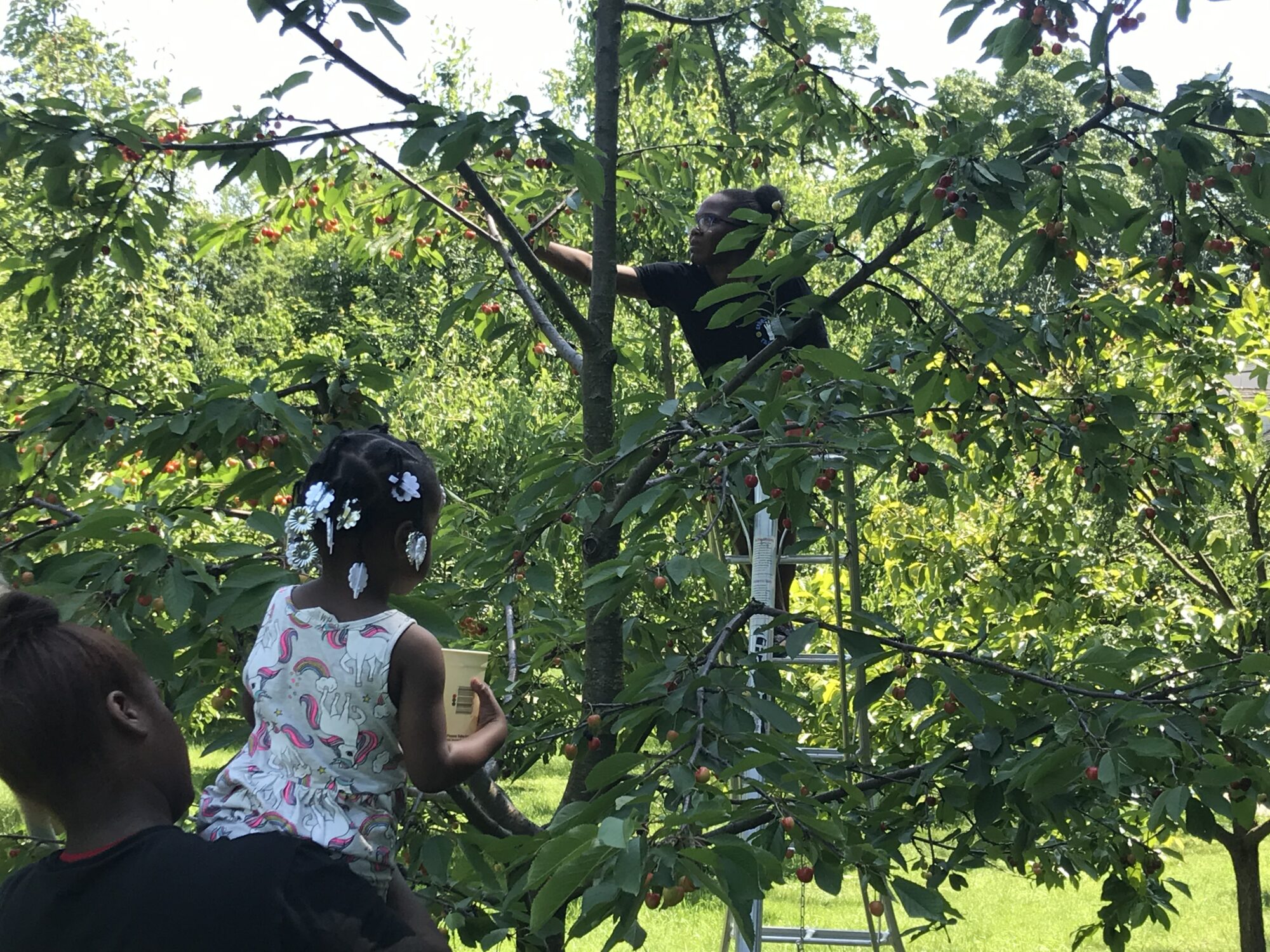
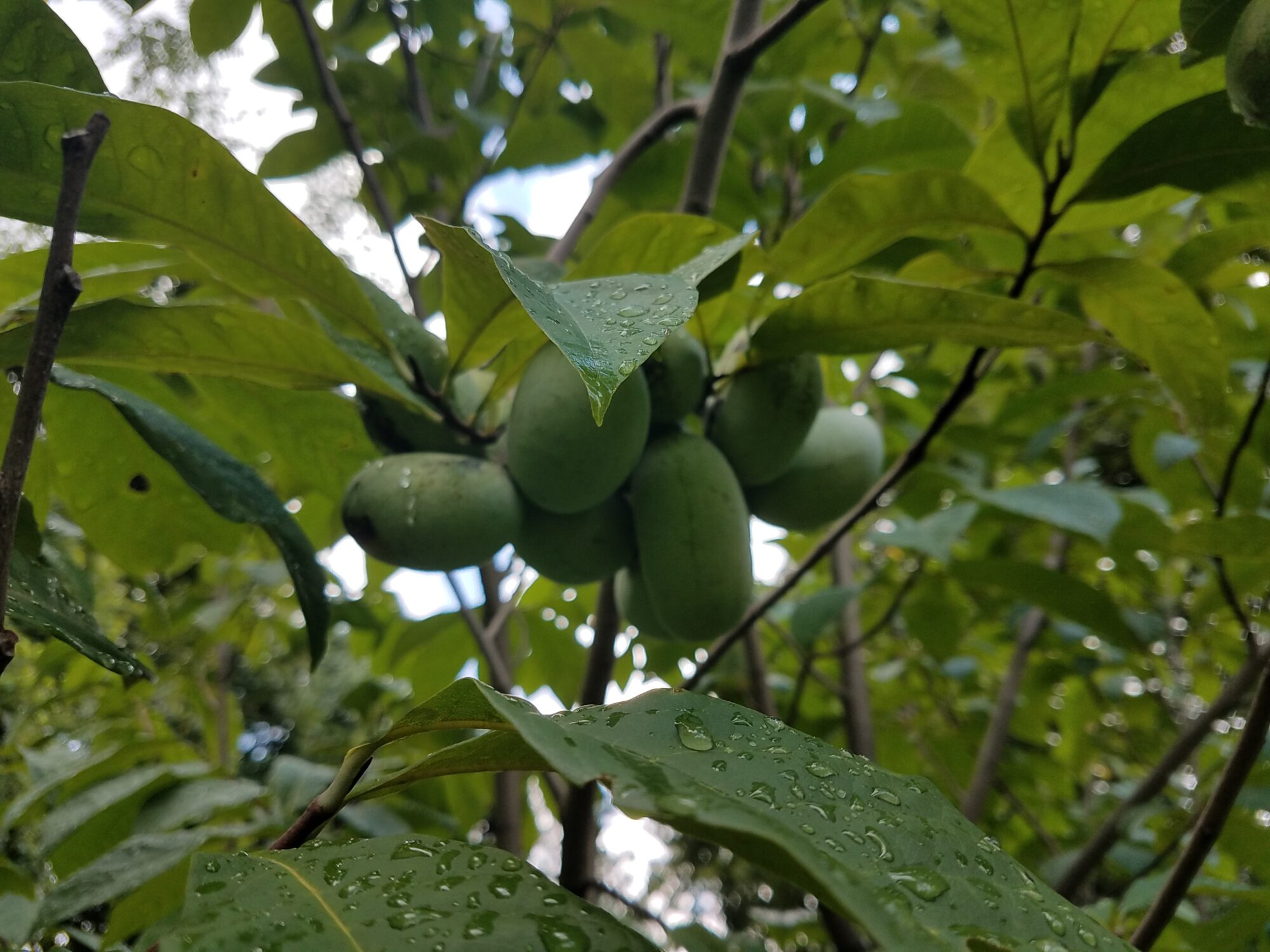
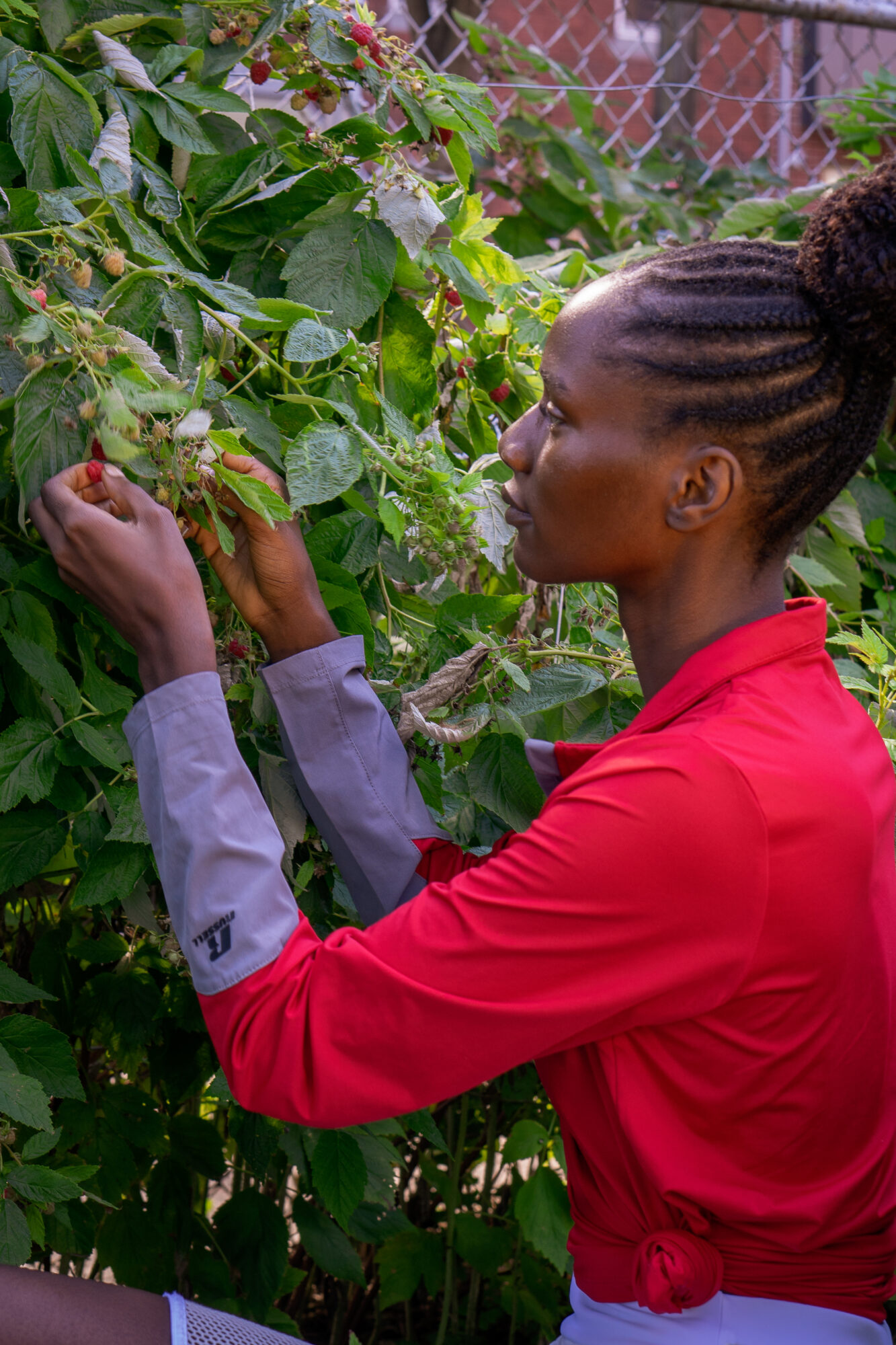
Out of 13 brambles, shrubs, vines, and perennial veg crops
- 9 increased from 2020-2021. Raspberries, Blackberries, Currants, Gooseberries, Elderberries, Blueberries, Goumis, Hardy Kiwis, and Nanking Cherries.
- 5 had highest yield on record: Blackberries, Hardy Kiwi, Elderberries, Goumis and Blueberries
- Elderberries and Goumis more than doubled previously reported harvest.
- 4 saw lowest harvest reported: Strawberries, Grapes, Asparagus, Rhubarb
- Grapes: SLF presence decreased in 2021, but plants still seem weakened.
Poundage from brambles, shrubs, vines, and perennial vegetables based on reported yields are as follows (bolded are record high yields):
- Raspberries: 236.5 pounds (138.6-2020, 167.3-2019, 200.5-2018, 395-2017, 429-2016, 230-2015)
- Strawberries: 46 pounds (189-2020, 264-2019, 224-2018, 173-2017, 327-2016, 433-2015)
- Blackberries: 374.75 pounds (251-2020, 147.6-2019, 191-2018, 125-2017, 201-2016,144-2015)
- Grapes: 43.5 pounds (61-2020, 197.8-2019, 118.6-2018, 130-2017, 65-2016, 129-2015)
- Currants: 25.7 pounds (5.25-2020, 17.75-2019, 17.25-2018, 10-2017, 53-2016, 56-2015)
- Gooseberries: 15.5. pounds (10.6-2020, 38-2019, 56.25-2018, 50-2017, 44-2016, 17-2015)
- Elderberries: 79 pounds (32-2020, 42.5-2019, 31-2018, 38-2017, 44-2016, 49-2015)
- Blueberries: 56.45 pounds (39-2020, 51-2019, 52-2018, 35-2017, 39-2016, 23-2015)
- Goumis: 26.9 pounds (12.25-2020, 10.9-2019, 15-2018, 10-2017, 21-2016, 11-2015)
- Hardy kiwis: 170 pounds (31.3-2020, 32-2019, 25-2018, 11-2017, 21-2016, 9-2015)
- Asparagus: 2 pounds (36.5-2020, 105-2019, 48.5-2018, 67-2017, 71-2016, 170-2015)
- Rhubarb: 18.3 pounds ( 35-2020, 111-2019, 56-2018, 40-2017, 25-2016, 40-2015)
- Nanking Cherries: 11 pounds, (8-2020, 65.1-2019, 32-2018, not previously tracked)
Large drop in reported mint and fennel harvest yield, large increase in comfrey harvest, and otherwise steady harvest reported across the board.
Poundage from culinary and medicinal herbs based on reported yields are as follows:
- Mint: 40 pounds (72.7-2020, 100-2019, 88-2018, 81-2017, 43-2016, 127-2015)
- Lemon balm: 41 pounds (40.9-2020, 30.5-2019, 45.6-2018, 29-2017, 36-2016, 33-2015)
- Oregano: 28.25 pounds (26.6-2020, 33.7-2019, 40-2018, 25-2017, 19-2016, 19-2015)
- Thyme: 39.45 pounds (34.5-2020, 25-2019, 36.75-2018, 24-2017, 17-2016, 25-2015)
- Anise Hyssop: 20.5 pounds (16-2020, 16.5-2019, 27-2018, 16-2017, 15-2016, 5-2015)
- Chamomile: 7 pounds (5.75-2020, 9.25-2019, 17-2018, 5-2017, 10-2016, not tracked prior)
- Fennel: 22.5 pounds (40.5-2020, 39-2019, 58-2018, 7-2017, 6-2016, not tracked prior)
- Sorrel: 13.25 pounds (13-2020, 6-2019, 14-2018, 12-2017, not tracked prior)
- Comfrey: 40 pounds (3.3-2020, 12-2019, 14.5-2018, 69-2017, not tracked prior)
Production Challenges and Recommendations
When asked to rate challenges in the orchard from 1-5, responses from partners averaged out to 3, which is slightly less challenging than the reported 3.5 average from partners last year. However, 67% of respondents believed it was harder to maintain their orchards in 2021 than in previous years (compared to 30% in 2020 and 56% in 2019 ). When comparing frequency of orchard care against rate of difficulty, partners that maintain their orchards at least once a week rated difficulty at an average of 3, while partners that maintain their orchards twice a month or less reported a difficulty rating of 3.5. Regular orchard care will result in less challenges, but it appears that the increased difficulty in orchard care this year compared to previous years is due to the ongoing lack of consistent orchard maintenance exacerbated by the continued effects of the COVID-19 pandemic. When asked what barriers there were to regular orchard maintenance 56% reported lack of time available to tend to the orchard, 32% reported staff transitions and 30% reported lack of availability due to COVID. Partners also reported less volunteers and volunteer groups in their orchard spaces due to ongoing volunteers returning to work as communities re-opened throughout the year.
As partner sites adjust to the effects of COVID-19, its ongoing host of variants and the continued staff turnover and transitions that often exist in urban agriculture often due to an inability to afford full-time staff, POP can offer support during periods of low staff capacity through expansion of the Lead Orchard Volunteers (LOVs) to upkeep monthly orchard care. Additionally, partner sites may find the POP Community Organizing Toolkit helpful for establishing ways to engage local community involvement and recruit volunteers for weekly or monthly workdays.
It is important to note that we recommend partner sites have the organizational capacity to maintain an orchard before agreeing to have it planted on their site. While POP can assist with the design, planting, resources and knowledge, providing ongoing monthly support and maintenance for all our partner sites is outside the capability of the organization. Orchards are planted under the agreement that they will be maintained by the site staff, volunteers and communities they are planted in.
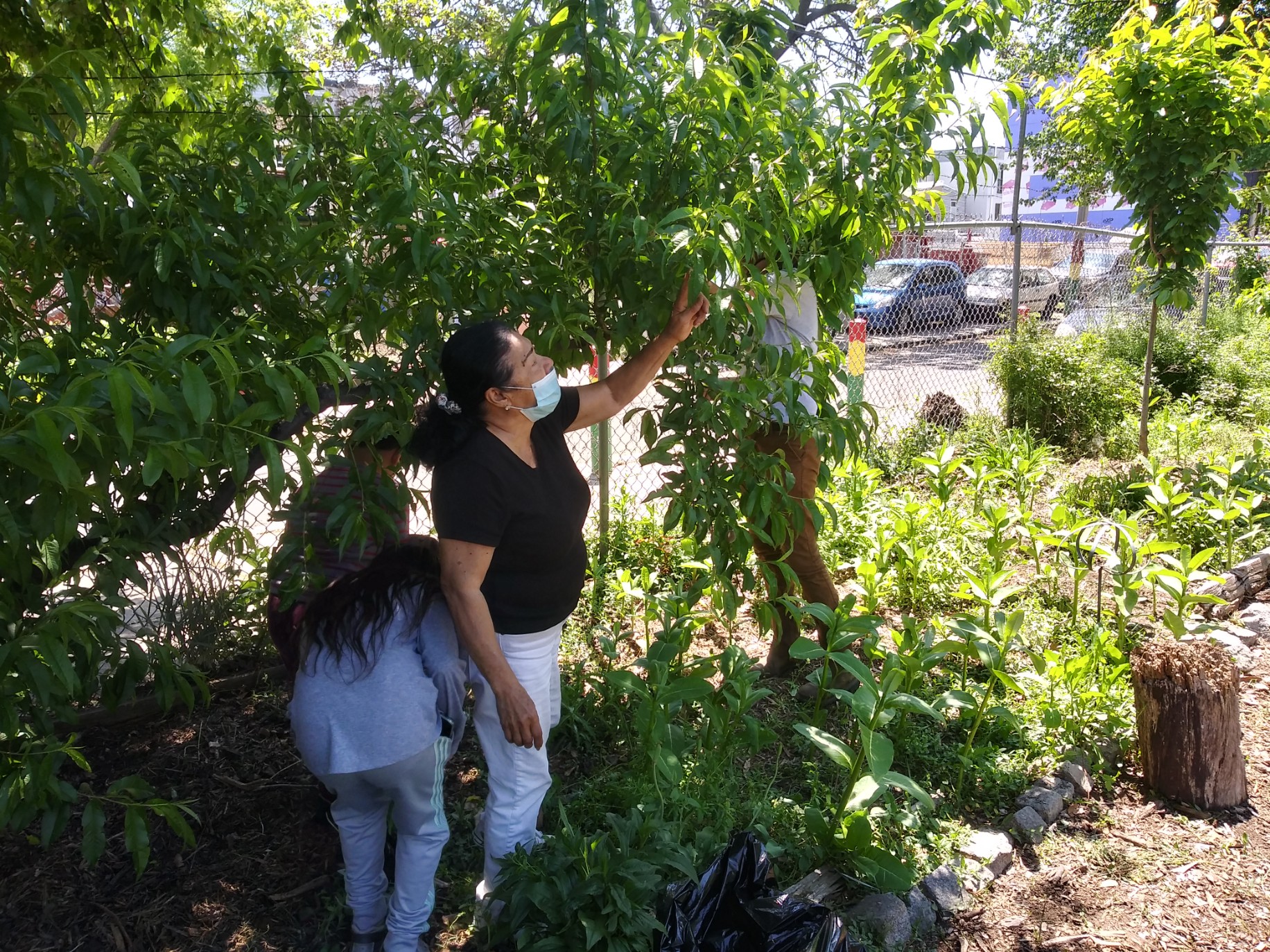
The most commonly reported challenges and the percentage of orchards reporting these challenges were: amount of time available (56.5%), plant diseases (45.7%), insect pests (41.3%), weeds (41.3%), squirrels (41.3%), staffing transitions (32.6%) amount of people involved due to COVID (30.4%) and watering (26.1%)
Plant disease was the second highest reported orchard challenge with peach leaf curl (32.6%), powdery mildew (30.4%), brown rot (26.1%), leaf spot (23.9%), cedar apple rust (17.4%) and fire blight (17.4%) continuing to be the most commonly reported diseases at partner sites. Pest challenges most commonly reported were the spotted lanternfly (39.1%), aphids (34.8%), mosquitos (26.1%), oriental fruit moth (19.6%), plum curculio (15.2%) and peach tree borer (13%). These reported pests and diseases impact common stone and pome fruit such as apples, peaches, plums, pears, nectarines and cherries which can be challenging to grow in our climate. POP can continue to educate current and potential partners on the benefits of planting uncommonly known fruit that are more pest and disease resistant, are easier to grow and maintain and yield prolific harvest.
When asked if partners would like more assistance in identifying challenges, 7 partners said yes (11 in 2020, 8 in 2019), 11 said somewhat (16 in 2020, 18 in 2019), 15 said no (8 in 2020, 10 in 2019), and 6 were unsure (6 in 2020, 14 in 201). This means at least 39% of respondents (63% 2020, 50% in 2019) think they would benefit from additional assistance in identifying challenges. This significant decrease could be in part to POP continuing to build it’s digital resources, assist specific partner sites with challenges through monthly and quarterly visits as needed and offer both hands-on and virtual workshops on ecological orchard care topics.
When asked “what might make next year better?” 60% of partner sites offered specific feedback. Of that, 44% overwhelmingly echoed more consistent time and attention to orchards and more volunteers, staff or interns. While this has consistently been reported as a primary challenge in previous years, along with the expansion of the LOV program, POP may need to pivot focus on how to best utilize the community toolkit to source support for local orchards that need more consistent hands. Also mentioned were more pest and disease guidance (22%), more weeding (7%), irrigation (3%) and learning about how to share knowledge with school educators on orchard care (3%).
Orchard Education Efforts
Last year, POP held a Virtual POPCORE Series, replacing the in-person POPCORE workshop series due to Covid. This year, POP is hosting both virtual and in-person workshops. It appears that most partners have not attended the Virtual POPCORE Series, but are interested in attending it. Out of all POPCORE classes, the Pruning and Eco-Orchard Care workshop was the most attended with 43% of partners having attended the class, followed by Pest and Disease Management (37%), Orchard Harvest and Use (24%), and Orchard and Food Forest Design was the least attended class (22%). This is common with workshop series, where attendance wanes as it progresses. There is also a clear pattern of partners responding that they would like to attend at much higher percentage then those who actually do, likely reflecting back that the biggest challenge for partners is having enough time to dedicate to the orchards. This year, all POPCORE classes were recorded and are available on POP’s YouTube channel for easy access when needed. Additionally, POP released a video series on pruning with easily digestible episodes in an effort to make information more accessible.
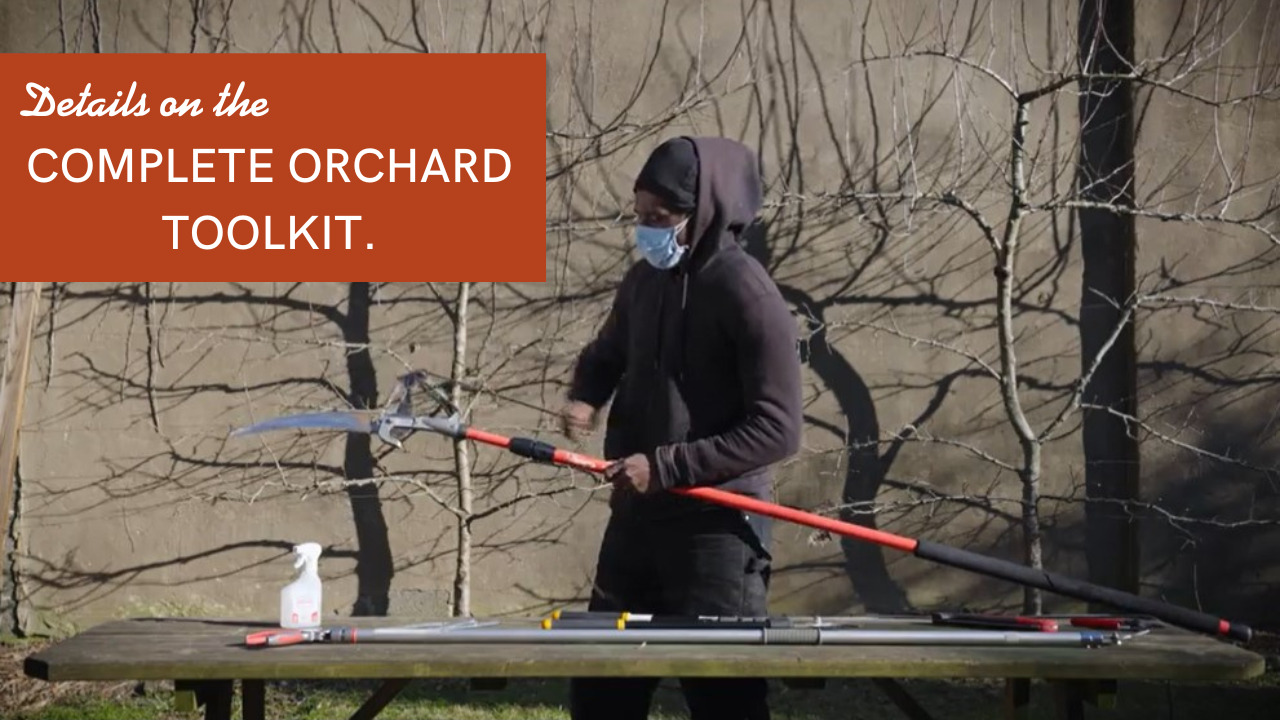
POPHarvestEd, a workshop program that provides a platform for people to learn about the different uses and traditions of harvested fruit from less common fruit trees. Last year, only 19.6% of partners attended a POPHarvestEd workshop and found them useful, while around 72% expressed interest in attending one. A very small percentage of partners are not interested in attending the workshops. The topics that partners are most interested in learning about are uncommon fruit, berries, indigenous herbs, medicinal herbs, and nuts.
Majority of partners are interested in a hybrid learning format (54%). Around 26% are interested in only in-person learning formats. Only 20% of partners are interested in a virtual only format. The hybrid format is preferred likely because it is more accessible and caters to the different ways people learn. Around 46% of partners have not attended POP virtual ed workshops but would like to.
After reaching out to partners about how POP can provide stronger guidance, there were similar patterns in the responses we received. Some recurring themes in partners’ requests were assistance with: pest management, squirrel deterrents, harvest processing, pruning, and community engagement. It seems that any gaps in knowledge regarding these issues can be at least partially filled in with educational workshops, both in-person and virtual.
POP Publications and Resources
Orchard Care Resources
- Pest and Disease guide: 74% of partners were aware of this resource (same as 2020). 100% of partners who knew about it found it helpful ( 87% very helpful, 13% moderately helpful).
- Monthly Orchard Task List: 65% of partners are aware of this resource (58% aware in 2020). 100% of those who knew about it found it to be helpful (77% very helpful, 23% moderately helpful).
- Weed ID Guide: 64% of partners knew about this resource. 100% of partners who knew about it found it helpful (70% very helpful, 30% moderately helpful).
- Plant Info Sheet: 61% of partners were aware of this resource. Of those, 96% found helpful (63% very helpful, 38% moderately helpful).
- Harvest Tracking Sheets: 53% of partners knew about this resource. Out of partners who knew about resource, 90% found helpful (15% very helpful, 75% moderately helpful).
POPHarvestED Resources
- Recipe Cards and DIY: 51% of partners aware of resource. Of those, 84% found helpful (52% very helpful, 32% moderately helpful).
- Curriculum and Lesson Plans: 45% of partners were aware of this resource. Of those 87% found helpful (50% very helpful, 37% moderately helpful).
- Rainbow Nutrition Cards: 33% of partners knew about this resource. Of those, 80% found helpful (33% very helpful, 47% moderately helpful).
Communicating with Community
- Food Forest Sign: 68% of partners were aware of this resource. Of those 83% found helpful (48% very helpful, 35% moderately helpful).
- Plant Signs: 50% of partners were aware of this resource. Of those 83% found helpful (70% very helpful, 13% moderately helpful).
- Community Organizing Toolkit: 32% of partners were aware of this resource. Of those who knew about resource 83% found helpful (25% very helpful, 58% moderately helpful).
Trainings
- Recorded POPCORE sessions: 51% of partners knew about this resource. 100% of those who knew about it found it helpful (53% very helpful, 47% moderately helpful).
- POPCORE Hands-On – 64% of partners were aware of this resource. 94% of those who knew about it found it helpful (72% very helpful, 24% moderately helpful).
Distribution of Information
- PHOG email: 66% of partners were aware of this resource. Of those who know about this resource, 96% found helpful (67% very helpful, 35% moderately helpful).
- BLOG posts: 65% of partners are aware of this resource. Of those who knew about it 83% found helpful (54% very helpful, 29% moderately helpful).
- Instagram: 59% of partners are aware of this resource. Of those who knew about it 59% found helpful (32% very helpful, 27% moderately helpful).
- Facebook: 58% of partners are aware of this resource. Of those 52% found helpful (14% very helpful, 38% moderately helpful).
Lead Orchard Volunteer Program
The POP Lead Orchard Volunteer Program is designed to match orchard partners with dedicated volunteers that have a certain level of training with POP, who could provide consistent, long-term involvement with an orchard, while expanding their knowledge in orchard care.
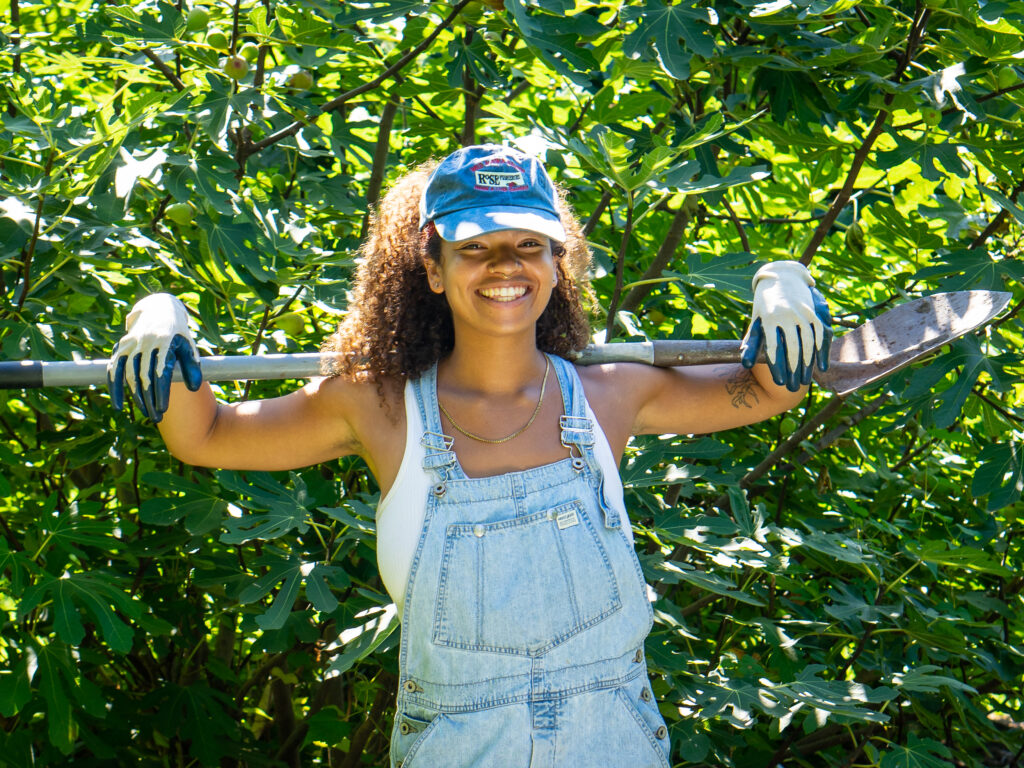
Through the years, it’s been observed that this program works best with sites that already have dedicated volunteers available to utilize available POP resources and guides with little to no POP staff attention needed.
According to our records, we had 34 LOVs at 16 sites in 2021, and 14 sites correctly identified that they had a LOV in 2021. 10 partner respondents (21.7%) were not sure if they had a dedicated LOV for their orchard compared to 33% back in 2020. This shows a significant increase in partners understanding the role and benefits of the LOV at their sites and as a part of their organization.
According to the analysis from this year’s Production Challenges, a majority of our partners’ primary struggle was establishing consistent orchard maintenance and expressed a need for more time, volunteers, and POP staff support. By continuing to develop this program’s structure through placement, training, check-ins, stipends, providing resources and support and the implementation of the LOV Stewardship program- a program where experienced lead orchard volunteers independently organize and lead workday without POP staff, we can hopefully provide consistent orchard care for sites that need it most. 39% of respondents are interested in LOVs (46% in 2021), 23.9% are open to the idea (34% in 2021), and 28.3% do not want LOV (20% in 2021). When asked if an LOV was beneficial to the orchard, 86.7% (13) answered Yes, 6.7% (1) answered No and 6.7% (1) answered Moderately.
When asked what could make the LOV program better and what could be done to improve a network of site based volunteers each season, notable feedback included:
- Creating more incentives for the volunteers
- For POP to be more mindful that LOVs had obligations outside of volunteering
- Provide clearer communication regarding the boundaries and responsibilities of the role
- For POP to organize opportunities for volunteers to communicate, interact and work with LOVs from sites other than their own
In our 2020 analysis, it was identified that in order for the LOV program to be successful there needed to be more structure and clarity around what the LOV program was and increased oversight from POP staff to expand the program for success. Since then, POP has:
- Created an LOV Interest Form for those interested in joining the program
- Created an Orientation Agreement document that clearly states the role expectations and responsibilities as well as providing preliminary orchard care resources
- Onboarded Orchard Manager, Sharon Appiah, to assist Phil and Kim with LOV program admin and logistics
- Started organizing LOV quarterly meetings on Zoom to discuss seasonal orchard tasks, provide resources for relevant topics depending on the time of the year and receive feedback or answer any questions LOVs may have
- Provide stipends that were self-determined based on individual need as a way to increase incentive. As of now 44% of POP LOVs receive stipends.
The LOV program is a great opportunity for both volunteers and partner sites. Those interested in ecological orchard care receive hands-on practice, especially if they don’t have access to their own fruit trees and edible perennials and sites needing consistent orchard care are able to have an ongoing steward care for their orchards throughout the seasons. A majority of site respondents reported having a favorable relationship with their LOVs. 91.7% of sites believed the experience was beneficial for their LOV. POP has the resources and knowledge to skill share with LOVs and by continuing to add more structure and streamlining the orientation and training process, the organization can move forward with adding more LOVs in the future and ideally, planting and supporting orchard spaces with ongoing volunteers equipped to care for these local orchards.
Organizational Improvement
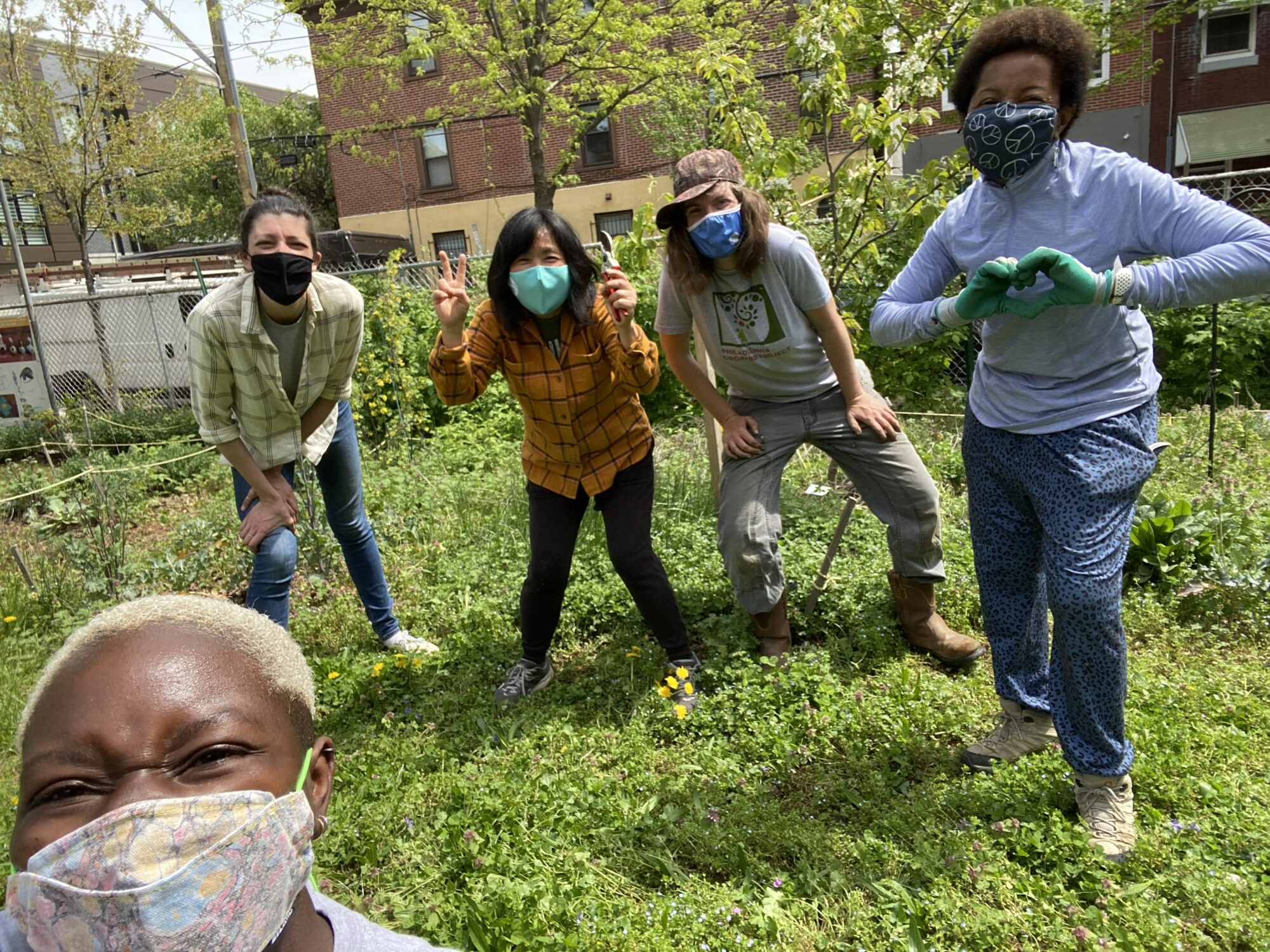
While this survey focuses on how POP can improve the support it provides, overall POP partners continue to rate our services as outstanding. On a scale from 1 to 10, respondents’ average rating of POP as an overall organization was a 9.4 (9.7 in 2020, 9.4 in 2019). It should be noted that this is not an anonymous survey and the results are also weighted by the 70% participation rate that assuredly skews towards the most active partnerships. In addition to the numerical rating, when partners were asked how POP could provide better support, most comments just expressed appreciation for that already being provided. A few partners mentioned more LOV’s, more staff visits, more hands-on training, consistent communication & scheduling, access to POP’s resources and workshops, and co-ordering of pest & disease management supplies.
The 2021 POP Partner Survey was conducted and analyzed by the whole POP team, with report abbreviated for the blog by Education Director Corrie Spellman-Lopez..
SUPPORT US! If you found this entry useful, informative, or inspiring, please consider a donation of any size to help POP in planting and supporting community orchards in Philadelphia: phillyorchards.org/donate.